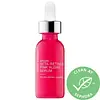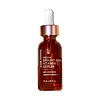What's inside
What's inside
 Key Ingredients
Key Ingredients

 Benefits
Benefits

 Concerns
Concerns

 Ingredients Side-by-side
Ingredients Side-by-side

Argania Spinosa Kernel Oil
EmollientCoconut Alkanes
EmollientOleyl Lactate
EmollientOctyldodecyl PCA
EmollientDimethyl Isosorbide
SolventIsosorbide Disunflowerseedate
HumectantSqualane
EmollientIsostearyl Lactate
EmollientGlyceryl Linoleate
EmollientPsoralea Corylifolia Seed Powder
Skin ConditioningCaprylic/Capric Triglyceride
MaskingEclipta Prostrata Extract
Skin ConditioningCocos Nucifera Oil
MaskingCoco-Caprylate/Caprate
EmollientGlyceryl Oleate
EmollientQuercus Suber Bark Extract
Skin ConditioningGlyceryl Palmitate
EmollientPterocarpus Marsupium Bark Extract
Hydrogenated Vegetable Oil
EmollientDipalmitoyl Hydroxyproline
Skin ConditioningMelia Azadirachta Leaf Extract
Skin ConditioningGlyceryl Linolenate
EmollientGlyceryl Stearate
EmollientOak Root Extract
Skin ConditioningLecithin
EmollientPalmitic Acid
EmollientDunaliella Salina Extract
Skin ConditioningCrithmum Maritimum Extract
Skin ConditioningMoringa Oleifera Seed Oil
EmollientOlea Europaea Fruit Oil
MaskingQuercetin
AntioxidantWater
Skin ConditioningTocopherol
AntioxidantGlycine Soja Oil
EmollientArgania Spinosa Kernel Oil, Coconut Alkanes, Oleyl Lactate, Octyldodecyl PCA, Dimethyl Isosorbide, Isosorbide Disunflowerseedate, Squalane, Isostearyl Lactate, Glyceryl Linoleate, Psoralea Corylifolia Seed Powder, Caprylic/Capric Triglyceride, Eclipta Prostrata Extract, Cocos Nucifera Oil, Coco-Caprylate/Caprate, Glyceryl Oleate, Quercus Suber Bark Extract, Glyceryl Palmitate, Pterocarpus Marsupium Bark Extract, Hydrogenated Vegetable Oil, Dipalmitoyl Hydroxyproline, Melia Azadirachta Leaf Extract, Glyceryl Linolenate, Glyceryl Stearate, Oak Root Extract, Lecithin, Palmitic Acid, Dunaliella Salina Extract, Crithmum Maritimum Extract, Moringa Oleifera Seed Oil, Olea Europaea Fruit Oil, Quercetin, Water, Tocopherol, Glycine Soja Oil
Argania Spinosa Kernel Oil
EmollientCoconut Alkanes
EmollientOleyl Lactate
EmollientOctyldodecyl PCA
EmollientTetrahexyldecyl Ascorbate
AntioxidantGlyceryl Oleate
EmollientDimethyl Isosorbide
SolventIsostearyl Lactate
EmollientBrassica Campestris Seed Oil
Skin ConditioningGlycyrrhiza Glabra Root Extract
BleachingPolyglyceryl-3 Diisostearate
EmulsifyingAlthaea Officinalis Root Extract
Skin ConditioningOryza Sativa Bran Extract
Skin ConditioningPterocarpus Marsupium Bark Extract
Bisabolol
MaskingPhloretin
AntioxidantCoco-Caprylate/Caprate
EmollientSqualane
EmollientOlea Europaea Fruit Oil
MaskingDunaliella Salina Extract
Skin ConditioningArgania Spinosa Kernel Oil, Coconut Alkanes, Oleyl Lactate, Octyldodecyl PCA, Tetrahexyldecyl Ascorbate, Glyceryl Oleate, Dimethyl Isosorbide, Isostearyl Lactate, Brassica Campestris Seed Oil, Glycyrrhiza Glabra Root Extract, Polyglyceryl-3 Diisostearate, Althaea Officinalis Root Extract, Oryza Sativa Bran Extract, Pterocarpus Marsupium Bark Extract, Bisabolol, Phloretin, Coco-Caprylate/Caprate, Squalane, Olea Europaea Fruit Oil, Dunaliella Salina Extract
Alternatives
Ingredients Explained
These ingredients are found in both products.
Ingredients higher up in an ingredient list are typically present in a larger amount.
You may know this ingredient as argan oil. Argan Oil has antioxidant, hydrating, and soothing properties.
Studies have shown argan oil can help fight again radical damage from the sun. This makes it effective at preventing hyperpigmentation.
Large amounts of vitamin E found in argan oil helps the skin retain water. Argan oil also contains fatty acids such as linoleic acid, oleic acid, and palmitic acid. It is also a good source of lipids.
Another benefit of argan oil is skin-soothing. It can help reduce inflammation-related skin symptoms.
Argan Oil is effective at regulating sebum production in pores. This can make it effective at treating hormonal acne.
Traditionally, argan oil was used for its antibacterial and antifungal properties. However, argan oil contains fatty acids that may make it not fungal-acne safe.
Argan Trees are native to Morocco.
Learn more about Argania Spinosa Kernel OilCoco-Caprylate/Caprate is created from fatty coconut alcohol, caprylic acid, and capric acid.
It is a lightweight emollient. Emollients create a thin barrier on the skin to trap moisture in. This helps keep your skin hydrated and soft.
Once applied, Coco-Caprylate/Caprate is absorbed quickly and leaves a silky feel.
Coco-Caprylate/Caprate may not be fungal acne safe.
Learn more about Coco-Caprylate/CaprateCoconut Alkanes is created from the fatty-acids of coconut oil. It is volatile, meaning it evaporates from the skin.
This ingredient is an emollient and solvent. As an emollient, it helps keep skin soft and hydrated. Solvents help distribute and mix other ingredients. This ensures a more even consistency.
Coconut Alkanes may not be fungal-acne safe.
Learn more about Coconut AlkanesDimethyl Isosorbide is a low-irritation solvent that helps deliver actives into your skin. It is created from glucose.
Research shows how well this ingredient works depends on the active and formulation rather than the concentration alone. This means adding more Dimethyl Isosorbide does not guarantee better penetration of ingredients into the skin.
We don't have a description for Dunaliella Salina Extract yet.
Glyceryl Oleate is the ester of glycerin and oleic acid. This ingredient is mainly an emollient and emulsifier.
Emollients soften and hydrate the skin by creating a thin film on top to trap in moisture. As an emulsifier, glyceryl oleate helps stabilize formulations by preventing ingredients such as oil and water from separating. According to a manufacturer, this ingredient helps helps thicken water-in-oil formulations, shower gels, and hair shampoos.
In some products, this ingredient may be used as a fragrance / perfuming ingredient. The scent of this ingredient is described to be "waxy".
Glyceryl oleate is created from oils rich in oleic acid, such as peanut oil and olive oil.
This ingredient may not be malassezia folliculitis safe.
Learn more about Glyceryl OleateWe don't have a description for Isostearyl Lactate yet.
We don't have a description for Octyldodecyl PCA yet.
Olea Europaea Fruit Oil is the fixed oil obtained from the ripe fruit of the Olive. In other words - olive oil.
The primary contents of olive oil are glycerides of the fatty acids linoleic, oleic and palmitic.
Olive oil also contains antioxidants such as Vitamin E. Antioxidants may help reduce signs of aging by fighting unstable free-radical molecules. It also contains Vitamins A (retinol), D, and K.
The squalene in olive oil makes it a great emollient. Emollients help soothe and soften your skin by trapping moisture in. This makes olive oil a great skin moisturizer.
Studies show olive oil to have antibacterial and antifungal properties in low concentrations. Another study found olive oil irritated sensitive oily skin. We always recommend speaking with a professional about using this ingredient in your routine.
Due to the fatty acid content, this ingredient may not be fungal-acne safe.
Learn more about Olea Europaea Fruit OilWe don't have a description for Oleyl Lactate yet.
We don't have a description for Pterocarpus Marsupium Bark Extract yet.
Squalane is an emollient that helps the skin hold onto moisture. It's an oily liquid that occurs naturally in certain types of fish and plant oils.
Because squalane boosts hydration in the skin, it also comes with plenty of benefits: it is an antioxidant and can help fight free radicals and skin damage. Squalane is also found to have a detoxifying effect when applied.
Squalane comes from squalene, which occurs naturally within the sebum of our skin. It is one of the oils our skin produces to keep itself hydrated. Squalane is the hydrogenated version of squalene and has a longer shelf life.
Research shows that squalane is non-irritating (even at 100% concentration).
In general, it's a fantastic ingredient. It does a great job at hydrating the skin, and it's suitable for those with sensitive skin.
The source of squalane may impact malassezia / fungal acne. This is because olive oil derived squalane can contain impurities such as fatty acids and plant waxes. Sugarcane derived squalane is recommended for anyone with malassezia concerns.
Is squalane vegan?
This depends on the source. Squalane can be derived from both plants and animals. Most squalane used in skincare comes from plants.
Please note: the source of squalane is only known if disclosed by the brand. We recommend reaching out to the brand if you have any questions about their squalane.
Read more about squalene with an "e".
Is squalane an oil?
Squalane is often called an oil, but it’s technically not; it’s a hydrocarbon, meaning it’s only made of carbon and hydrogen, unlike true oils which are triglycerides made of fatty acids and glycerol.
The term “oil-free” isn’t regulated, so companies can define it however they want. Some exclude all oils, while others just avoid mineral oil or comedogenic oils.
While some people avoid oils thinking they cause breakouts, the right kind of oil (or oil-like ingredient like squalane) can actually help balance and hydrate your skin. It’s worth testing out simple oils or squalane to see what works best for your skin.
Learn more about Squalane